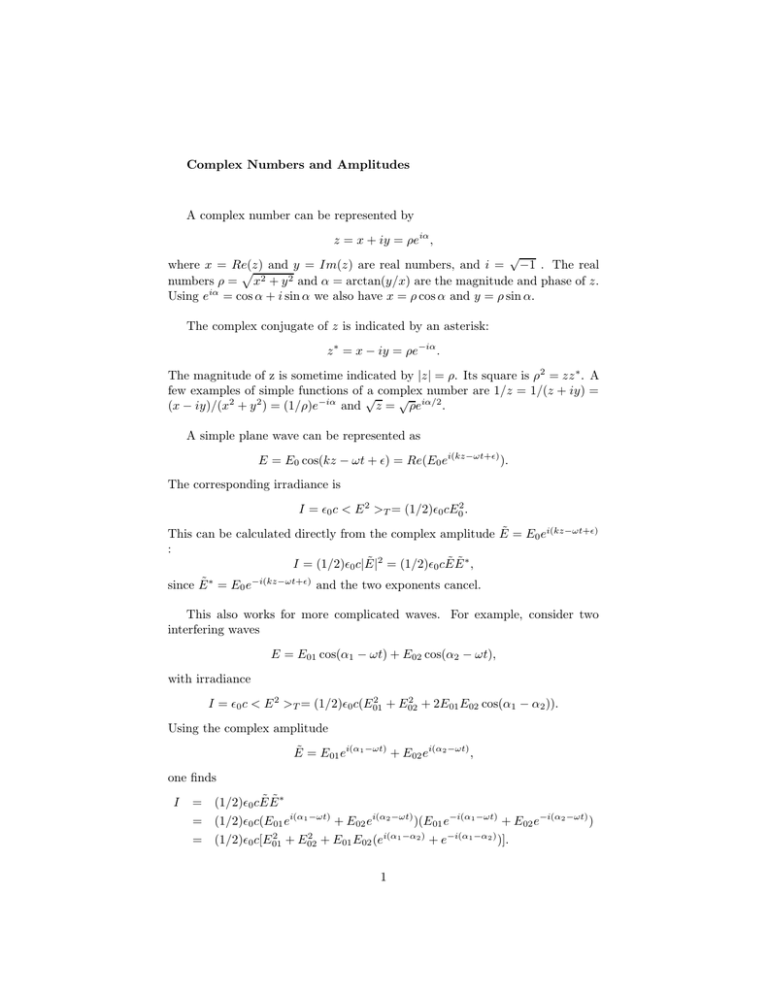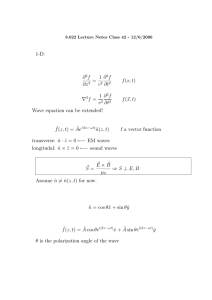Complex Numbers and Amplitudes A complex number can be
advertisement

Complex Numbers and Amplitudes A complex number can be represented by z = x + iy = ρeiα , √ where x = Re(z) p and y = Im(z) are real numbers, and i = −1 . The real numbers ρ = x2 + y 2 and α = arctan(y/x) are the magnitude and phase of z. Using eiα = cos α + i sin α we also have x = ρ cos α and y = ρ sin α. The complex conjugate of z is indicated by an asterisk: z ∗ = x − iy = ρe−iα . The magnitude of z is sometime indicated by |z| = ρ. Its square is ρ2 = zz ∗ . A few examples of simple functions of √ a complex number are 1/z = 1/(z + iy) = √ (x − iy)/(x2 + y 2 ) = (1/ρ)e−iα and z = ρeiα/2 . A simple plane wave can be represented as E = E0 cos(kz − ωt + ) = Re(E0 ei(kz−ωt+) ). The corresponding irradiance is I = 0 c < E 2 >T = (1/2)0 cE02 . This can be calculated directly from the complex amplitude Ẽ = E0 ei(kz−ωt+) : I = (1/2)0 c|Ẽ|2 = (1/2)0 cẼ Ẽ ∗ , since Ẽ ∗ = E0 e−i(kz−ωt+) and the two exponents cancel. This also works for more complicated waves. For example, consider two interfering waves E = E01 cos(α1 − ωt) + E02 cos(α2 − ωt), with irradiance 2 2 I = 0 c < E 2 >T = (1/2)0 c(E01 + E02 + 2E01 E02 cos(α1 − α2 )). Using the complex amplitude Ẽ = E01 ei(α1 −ωt) + E02 ei(α2 −ωt) , one finds I = (1/2)0 cẼ Ẽ ∗ = (1/2)0 c(E01 ei(α1 −ωt) + E02 ei(α2 −ωt) )(E01 e−i(α1 −ωt) + E02 e−i(α2 −ωt) ) 2 2 = (1/2)0 c[E01 + E02 + E01 E02 (ei(α1 −α2 ) + e−i(α1 −α2 ) )]. 1 Since ei(α1 −α2 ) + e−i(α1 −α2 ) = 2 cos(α1 − α2 ) , this is identical to the previous expression. In many cases the complex representation approach is simpler: one simply adds together different terms with their phases expressed in terms of the exponentials of imaginary expression, and then multiplies this sum by its complex conjugate (with all of the phases changing sign) to get the irradiance. The interference terms come from product of different terms in the two sums for which the two phases do not, in general, cancel. 2



